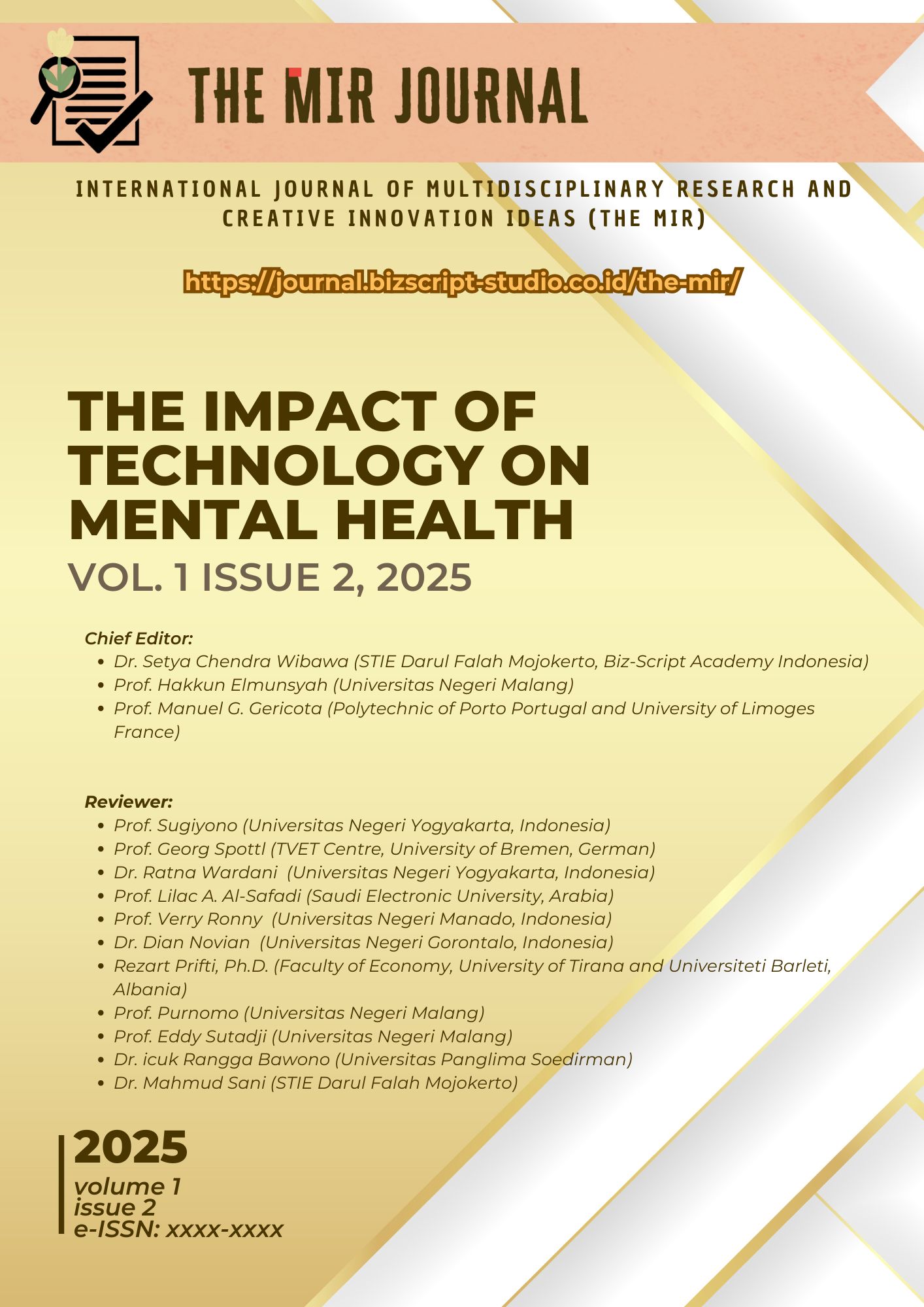Toxic Relationship Prevention and Counseling Strategies to Maintain Students' Mental Health
Keywords:
Strategy, Prevention, Counseling, Toxic Relationship, Mental Health, Students.Abstract
The high cases of toxic relationships that negatively impact the mental health of adolescents and students, as well as the lack of effective prevention and counseling strategies. Toxic relationships can lead to psychological disorders such as stress, depression, and decreased self-esteem that threaten their mental well-being. The purpose of this study is to identify strategies for prevention and counseling of toxic relationships to maintain the mental health of adolescents and students. The research method used was qualitative with data collection through in-depth interviews and observations, as well as population sampling involving adolescents and students who had experienced or been exposed to toxic relationships, psychologists, and campus counselors. Data are analyzed narratively to understand experiences and effective strategies in preventing toxic relationships. The results of the study show that psychoeducational education and training are very effective in increasing the awareness and skills of adolescents and students in recognizing the signs of toxic relationships and managing interpersonal relationships in a healthy manner. In addition, social support from family, friends, and the campus environment plays an important role in helping individuals get out of toxic relationships and restore their mental health. The conclusion of the study confirms that integrated prevention and counseling strategies can reduce the prevalence of toxic relationships and their negative impact on the mental health of adolescents and students. The implication of this study is the need to develop continuing education programs in the school and campus environment as well as the increasing role of mental health professionals in providing preventive support and early intervention.
Keywords: Strategy, Prevention, Counseling, Toxic Relationship, Mental Health, Students.
Downloads
References
Ademoyegun, A. B., Ibitoye, A. G., Afolabi, J., Idowu, O. A., Fawole, H., Awotidebe, T. O., & Mbada, C. E. (2024). Can physical activity attenuate the impact of internet addiction on anxiety in young adults? A moderation analysis. Journal of Affective Disorders Reports, 16(December 2023), 100718. https://doi.org/10.1016/j.jadr.2024.100718
Ahmad, F. M., & Sajit, D. M. (2024). Exploring the relationship between trauma, mental health, and occupational performance in health science center students. Frontiers in Public Health, 12(December), 1–10. https://doi.org/10.3389/fpubh.2024.1398238
Alexander, E. D., Chung, V. H. A., Yacovelli, A., Sarmiento, I., & Andersson, N. (2024). Social media and postsecondary student adoption of mental health labels: Protocol for a scoping review. BMJ Open, 14(2), 1–5. https://doi.org/10.1136/bmjopen-2023-078193
Carnegie, G. (2020). Research Methodology. In Pastoral Accounting in Colonial Australia. https://doi.org/10.4324/9781315052649-15
Chowdhury, A. H., Rad, D., & Rahman, M. S. (2024). Predicting anxiety, depression, and insomnia among Bangladeshi university students using tree-based machine learning models. Health Science Reports, 7(4). https://doi.org/10.1002/hsr2.2037
Ehsan, H., Ramakee, A. W., Barakati, T., Yosufi, A., Azimi, S., Aminpoor, H., Eshraqi, A. M., Kamal, F., Ghazanfari, F., Ibrahimkhil, M. A., Nikyar, M. E., & Karimi, A. S. (2024). The Impact of Social Media in Afghanistan: A Multi-Disciplinary Study. Journal of Multidisciplinary Healthcare, 17(July), 3121–3139. https://doi.org/10.2147/JMDH.S468845
Hammad, M. A., Alyami, M. H. F., & Awed, H. S. (2024). The association between internet addiction and sleep quality among medical students in Saudi Arabia. Annals of Medicine, 56(1). https://doi.org/10.1080/07853890.2024.2307502
Hyseni Duraku, Z., Davis, H., & Hamiti, E. (2023). Mental health, study skills, social support, and barriers to seeking psychological help among university students: a call for mental health support in higher education. Frontiers in Public Health, 11(October). https://doi.org/10.3389/fpubh.2023.1220614
Ji, H. (2024). Applied Mathematics and Nonlinear Sciences A Study on the Construction of Mental Health Indicators for College Students Based. 9(1), 1–18.
Kabir, H., Nasrullah, S. M., Hasan, M. K., Ahmed, S., Hawlader, M. D. H., & Mitra, D. K. (2021). Perceived e-learning stress as an independent predictor of e-learning readiness: Results from a nationwide survey in Bangladesh. PLoS ONE, 16(10 October), 1–18. https://doi.org/10.1371/journal.pone.0259281
Makhmud, A., Thornicroft, G., & Gronholm, P. C. (2022). Indirect social contact interventions to reduce mental health-related stigma in low-And middle-income countries: Systematic review. Epidemiology and Psychiatric Sciences, 31. https://doi.org/10.1017/S2045796022000622
Mohamad, I. N. F., Mubin, N. N. A., & Jusoh, A. J. (2024). The Role of Instagram in Promoting Mental Health Awareness and Help-Seeking Attitudes Among Malaysian University Students. Jurnal Komunikasi: Malaysian Journal of Communication, 40(3), 417–433. https://doi.org/10.17576/JKMJC-2024-4003-24
Neuman, W. L. (2014). Pearson New International Edition Social research methods: Qualitative and Quantitative approaches. In Pearson. https://www.amazon.co.uk/Social-Research-Methods-Quantitative/dp/0205786839/ref=sr_1_5?s=books&ie=UTF8&qid=1461496914&sr=1-5&keywords=social+research+methods+qualitative+and+quantitative+approaches
Nu Htay, M. N., Parial, L. L., Tolabing, M. C., Dadaczynski, K., Okan, O., Man Leung, A. Y., & Su, T. T. (2022). Digital health literacy, online information-seeking behaviour, and satisfaction of Covid-19 information among the university students of East and South-East Asia. PLoS ONE, 17(4 April), 1–17. https://doi.org/10.1371/journal.pone.0266276
Nuñez Fadda, S. M., Ciambelli Romero, H. C., Gradilla Lizardo, N. S., & Sánchez Castillón, J. A. (2024). An Ecological Inquiry on Young People’s Suicidal Ideation at University: Individual, Relational and Cultural Factors and Their Interactions. European Journal of Investigation in Health, Psychology and Education, 14(1), 64–86. https://doi.org/10.3390/ejihpe14010005
Petrovc, A. (2011). Media Environment Environment. European Journal Of Communication, 17, 1780–1793. file:///Users/andreayee/Documents/Mendeley Desktop/European Journal of Communication-2011-Petri?-116-32.pdf
Radovic, A., Li, Y., Landsittel, D., Odenthal, K. R., Stein, B. D., & Miller, E. (2022). A Social Media Website (Supporting Our Valued Adolescents) to Support Treatment Uptake for Adolescents With Depression or Anxiety: Pilot Randomized Controlled Trial. JMIR Mental Health, 9(10). https://doi.org/10.2196/35313
Remskar, M., Western, M. J., Maynard, O. M., & Ainsworth, B. (2022). Exercising body but not mind: A qualitative exploration of attitudes to combining physical activity and mindfulness practice for mental health promotion. Frontiers in Psychology, 13(December), 1–13. https://doi.org/10.3389/fpsyg.2022.984232
Selvakumar, V., Venkata, T. P., Venkata, T. P., & Singh, S. (2023). Predicting primary and middle-school students’ preferences for online learning with machine learning. South African Journal of Childhood Education, 13(1), 1–6. https://doi.org/10.4102/sajce.v13i1.1324
Staccini, P., & Lau, A. Y. S. (2022). Consuming Health Information and Vulnerable Populations: Factors of Engagement and Ongoing Usage. Yearbook of Medical Informatics, 31(1), 173–180. https://doi.org/10.1055/s-0042-1742549






